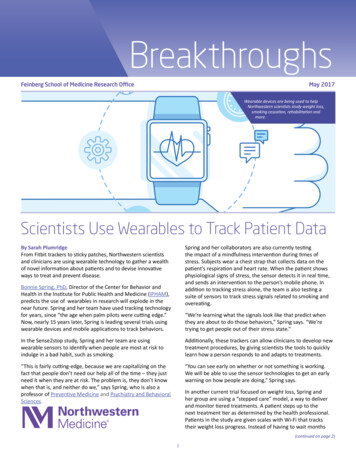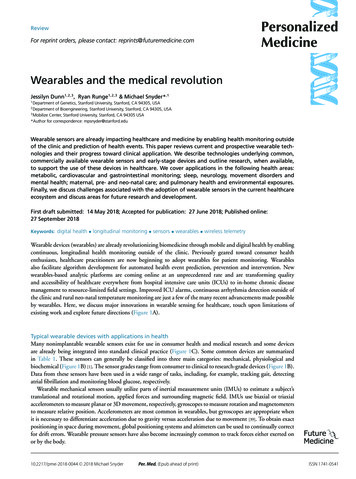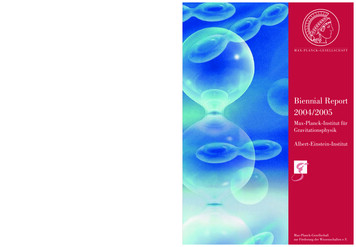
Transcription
Feinberg School of Medicine Research OfficeMay 2017Wearable devices are being used to helpNorthwestern scientists study weight loss,smoking cessation, rehabilitation andmore.Scientists Use Wearables to Track Patient DataBy Sarah PlumridgeFrom Fitbit trackers to sticky patches, Northwestern scientistsand clinicians are using wearable technology to gather a wealthof novel information about patients and to devise innovativeways to treat and prevent disease.Spring and her collaborators are also currently testingthe impact of a mindfulness intervention during times ofstress. Subjects wear a chest strap that collects data on thepatient’s respiration and heart rate. When the patient showsphysiological signs of stress, the sensor detects it in real time,and sends an intervention to the person’s mobile phone. Inaddition to tracking stress alone, the team is also testing asuite of sensors to track stress signals related to smoking andovereating.Bonnie Spring, PhD, Director of the Center for Behavior andHealth in the Institute for Public Health and Medicine (IPHAM),predicts the use of wearables in research will explode in thenear future. Spring and her team have used tracking technologyfor years, since “the age when palm pilots were cutting edge.”Now, nearly 15 years later, Spring is leading several trials usingwearable devices and mobile applications to track behaviors.“We’re learning what the signals look like that predict whenthey are about to do those behaviors,” Spring says. “We’retrying to get people out of their stress state.”In the Sense2stop study, Spring and her team are usingwearable sensors to identify when people are most at risk toindulge in a bad habit, such as smoking.Additionally, these trackers can allow clinicians to develop newtreatment procedures, by giving scientists the tools to quicklylearn how a person responds to and adapts to treatments.“This is fairly cutting-edge, because we are capitalizing on thefact that people don’t need our help all of the time – they justneed it when they are at risk. The problem is, they don’t knowwhen that is, and neither do we,” says Spring, who is also aprofessor of Preventive Medicine and Psychiatry and BehavioralSciences.“You can see early on whether or not something is working.We will be able to use the sensor technologies to get an earlywarning on how people are doing,” Spring says.In another current trial focused on weight loss, Spring andher group are using a “stepped care” model, a way to deliverand monitor tiered treatments. A patient steps up to thenext treatment tier as determined by the health professional.Patients in the study are given scales with Wi-Fi that trackstheir weight loss progress. Instead of having to wait months(continued on page 2)1
Feinberg School of Medicine Research OfficeBreakthroughsMay 2017Wearables(continued from cover page)to know if the treatment is working, care providers can knowwithin two weeks whether the patient is responding.In addition to their use in prevention, wearable devices are alsobeing used in rehabilitation. Christine Pellegrini, PhD, adjunctassistant professor of Preventive Medicine, currently uses Fitbitactivity trackers in a pilot study to track physical activity levels inpatients who have had knee replacement surgery.Pellegrini and her team are following two groups of patients forfour months within the first year after their surgery. One groupof patients will receive a Fitbit alone, while the other group willreceive Fitbits for themselves and a buddy. Pellegrini hopes tolearn if simply providing a wearable device will increase physicalactivity, as well as determining whether having a friend, spouseor coworker connected with them through the activity trackerapp motivates patients to be even more active.Arun Jayaraman, PhD, displays many of the wearable technologies used in hislab to help collect data from patients at the Shirley Ryan AbilityLab.Also a professor of Medical Social Sciences and PhysicalTherapy and Human Movement Sciences, Jayaraman iscurrently conducting more than 20 studies at the lab, fromgloves that measure the mechanics of wheelchair use forshoulder injury research to next-generation prostheses withadvanced technology to prevent falls in amputees.The activity trackers are potentially valuable for kneereplacement patients, because though they to physical therapyafter surgery, therapy alone may not provide the necessarymotivation to lead a healthy, active lifestyle.“We will be able to get an idea of overall physical activity andcome up with potential recommendations for orthopedicsurgeons and physical therapists. With the buddy system, we arelooking at different social support constructs. Ultimately, we arelooking to explore different options. Currently, there isn’t muchon lifestyle and physical activity guidelines on a daily basis forthese patients,” Pellegrini said.In collaboration with John Rogers, PhD, the Louis Simpsonand Kimberly Querrey Professor of Materials Science andEngineering, Biomedical Engineering and Neurological Surgery,Jayaraman is testing an adhesive skin device for an inpatientstroke study that monitors sleep, heart rate, stress, activity andmore.“Patient monitoring allows clinicians to know what happenswhen a patient gets a medication or goes to physical therapy,”Jayaraman says. “We can use the data from the monitors toquantify a patient’s medication or their surgical or therapeuticintervention.”At the Shirley Ryan AbilityLab in the Center for Bionic Medicine,Arun Jayaraman, PhD, associate professor of Physical Medicineand Rehabilitation, uses wearable sensors and novel machinelearning techniques for outcomes research in patients withphysical disabilities.A large part of his team’s time is spent on customizingmonitors to different patient populations. Jayaraman stressesthe limitations of commercial sensor technology, which isusually calculated to pick up simple patterns in healthy, youngindividuals.CONTENTSFaculty profile: Issam Ben-Sahra3Computational Research Day /Nano-technology4Student profile: Megan Novak5Staff profile: Keith Herzog6In the news and NUCATS corner7Sponsored research/New faculty8Funding9Galter Library connection10High-impact research11Events and NIH news12“It takes a lot of time and work to develop advanced machinelearning techniques,” Jayaraman says. “There is a lot of overor under-prediction of performance in devices such as Fitbits,and for the average person, an approximate calculation is okay,but for patients where physicians may want to change a drugdosage, therapy plan or gauge whether surgery is needed, it’simportant to have accurate and precise data.”Jayaraman envisions a future where wearables will “talk” torobots to assist or protect patients. With newly-developedsensors becoming ever-smaller, Jayaraman predicts they willeventually become non-contact sensors, which in the futurewould be able to sweep a room and pick up detailed data on allof the people moving within.2
Feinberg School of Medicine Research OfficeBreakthroughsMay 2017Revealing Metabolic Changes in Tumor CellsIssam Ben-Sahra, PhD, assistant professor of Biochemistry andMolecular GeneticsQ&AWhat are your research interests?My research interests lie in the field of cancer biology and metabolic pathways. Mylab seeks to define the key molecular links between oncogenic events and cellularmetabolism. In particular, we pursue to identify novel connections between oncogenicsignaling and metabolic pathways required for nucleotide synthesis.While a graduate student at theUniversity of Sophia-Antipolis inNice, France, Issam Ben-Sahra, PhD,assistant professor of Biochemistryand Molecular Genetics, becameinterested in studying the role ofmetabolic changes on cancer cellsand tumor growth. This work hasdriven him to further study theregulation of metabolic pathways incancer, specifically understandingthe impact of mTOR-stimulatedpathways.Before joining Northwestern in 2016,Ben-Sahra completed a postdoctoralfellowship at Harvard School ofPublic Health where he studiedhow the protein complex mTORC1drives anabolic cell growth andproliferation. He is also a member ofthe Robert H. Lurie ComprehensiveCancer Center of NorthwesternUniversity.What is the ultimate goal of your research?Deciphering the interplay between oncogenic processes and metabolic pathwaysthat contribute to metabolic reprogramming in a given setting may serve as a criticalfactor in determining therapeutic targets that yield maximal drug efficacy with minimaldeleterious effect on normal cells. The goal of my research program is to facilitatefurther progress in the exploitation of atypical metabolic features in cancer as a meansof therapeutic intervention.How does your research advance medical science and knowledge?My lab is focused on the regulation of nucleotide synthesis by oncogenes. Decodinghow nucleotide metabolism is rewired in specific types of cancer can improve ourunderstanding and therapeutic strategies to more specifically eradicate cancer cells.How did you become interested in this area of research?I am fascinated by all sciences, especially mathematics, astronomy and biochemistry. Iwas always interested in understanding how cancer cells or proliferative cells alter theirmetabolic program to maintain cell autonomous proliferation. When I was a graduatestudent, I became interested in studying the role of metabolic stress-inducing agentsin cancer cell survival. My PhD work elucidated the role of metabolic perturbations oncancer cell viability, and we were among the first to uncover the anti-cancer propertiesof the anti-diabetic drug metformin. Indeed, we demonstrated that metformin inhibitsprostate cancer cell growth and proliferation through alteration of cellular metabolism.This work led me to dive in further into the regulation of metabolic pathways bysignaling pathways in cancer.How is your research funded?My research is funded by the K99/R00 grant from the National Institute of Health andNational Cancer Institute (NIH/NCI). This is a grant that helped me get the opportunityto obtain a faculty position and start my own lab at Northwestern University.What are some of your personal hobbies/interests?When I have some spare time, I read about astronomy and new discoveries in this field.I am fascinated by the immensity of our universe (or multiverse) and the opportunity offinding Earth-like planets where different forms of life could have spread.3
Feinberg School of Medicine Research OfficeBreakthroughsMay 2017Insights From Computational Research DayNorthwestern’s 4th annual Computational Research Day broughttogether more than 350 faculty members and students toshowcase innovative research projects, share recent insights andtools, and strengthen the computational research communitythroughout the university.The event, co-sponsored by Feinberg and hosted by NorthwesternInformation Technology on the Evanston campus, featuredpresentations, a poster competition, workshops, software demosand group discussions, all centered on leveraging computationalmethods to answer complex research questions.Rex Chisholm, PhD, vice dean of Scientific Affairs and GraduateEducation, kicked off the conference with an opening addressdiscussing the Northwestern Medicine Enterprise DataWarehouse, which currently holds more than 40 terabytes ofclinical and research data.The annual Northwestern Computational Research Day and poster sessionwas held April 18 on the Evanston campus.“We are in a completely different world today, where insteadof paper records, everybody’s health is now captured in anelectronic record,” said Chisholm, also the Adam and RichardT. Lind Professor of Medical Genetics. “The ability to put thatdata together in a single place and start to think about big dataapproaches to identifying patterns in that collection of data is amajor game-changer.”Elizabeth McNally, MD, PhD, director of the Center forGenetic Medicine, delivered a keynote address on humangenome sequencing and echoed the opportunities offered bycomputational research. “This really is an area where there hasbeen a lot of need for big data analysis — and it’s definitely notshrinking anytime soon,” said McNally, also the Elizabeth J. WardProfessor of Genetic Medicine.Elizabeth McNally, MD, PhD, director of the Center for Genetic Medicine,delivered the keynote address at Computational Research Day, on humangenome sequencing.In addition to biomedical research, the conference alsohighlighted the use of computing in a wide range of otherdisciplines, from economics and engineering to applied physicsand the social sciences. A guest keynote address was delivered byDesmond Patton, PhD, MSW, assistant professor at the ColumbiaUniversity School of Social Work, who presented on his researchinto innovating gang violence prevention through qualitativeanalysis and natural language processing of social media data. Thespeakers were followed by a poster session and poster awardsceremony.Yoonjung Yoonie Joo, a Health and Biomedical InformaticsPhD student in the Driskill Graduate Program (DGP), receivedsecond-place for “Phenome-wide Association Studies ofPolycystic Ovary Syndrome (PCOS),” her research with principalinvestigator M. Geoffrey Hayes, PhD, associate professor ofMedicine in the Division of Endocrinology. The first-place prizewas awarded to Shannon Brady, in the Weinberg College of Artsand Sciences, with third-place going to Jamilah Silver, in theSchool of Education and Social Policy.Spotlight on Nanotechnology ResearchThe Big Ten Network recently visited the lab of C. Shad Thaxton, MD, PhD,associate professor of Urology, to showcase his work in nanotechnology.The focus of Thaxton’s lab is to control the synthesis of structures thatnaturally interface with biological systems to develop exquisitely targeted,practical, safe, and effective nanoparticle therapeutics, imaging agents,and biosensors. Watch the video.4
Feinberg School of Medicine Research OfficeBreakthroughsMay 2017Investigating the Roles Alpha-Catenin Play in Cell-Cell AdhesionMegan Novak, Driskill Graduate Program is Life SciencesWhat exciting projects are you working on?Most of the experimental methods I use during my PhD studiesinvolve the use of the microscopes at the Center for AdvancedMicroscopy on the Feinberg campus. I love live cell imaging andwatching proteins move around within the cell. One particularlycool experiment I recently did for a paper revision involvedadding a fluorescently-tagged membrane phospholipid into apart of the cell where that lipid is not normally found. Usingtime-lapse live cell imaging, I was able to watch my proteinof interest (tagged with a different colored fluorophore) getrecruited to the site where this phospholipid was exogenouslyadded. This experiment showed that the phospholipid wassufficient to recruit my protein of interest. I was also able tointroduce point mutations into my protein of interest thatreduced this recruitment to the newly added phospholipid,suggesting that these amino acids contribute to the interactionbetween my protein and the phospholipid.Megan Novak, a fourthyear student in theDriskill Graduate Programin Life Sciences (DGP),studies dysregulatedcell-cell adhesion incancer progression in thelaboratory of Carl Gottardi,PhD, associate professorof Medicine in the Divisionof Pulmonary and CriticalCare.Novak earned herundergraduate degree inChemistry from FurmanUniversity. She plans to work in higher education advising,specifically with STEM students to help them learn to translatetheir quantitative, analytical and critical thinking skills into skillsthat are broadly applicable for any career.What attracted you to the PhD program?I was an undergraduate chemistry major with a strong interestin biology, so I was really drawn to the integrated scienceprograms where I could complete rotations in different in fieldsbefore choosing a thesis lab. I also knew that I did not want torun my own lab after graduation, so I looked for an institutionthat supported a variety of careers after completing a PhD.Northwestern has so many certificate programs and master’sprograms to support professional development beyondbench research – teaching, business management, clinicalinvestigation, and science law to name a few – that I felt Iwould be well-supported no matter what career path I chose.Q&AWhere is your hometown?I lived all over growing up, but I have now officially lived inChicago long enough that I call it home. There’s nothing quitelike flying into Chicago over Lake Michigan. Every time I seethe skyline from that prospective, I think to myself that I live insuch an incredible, beautiful city.What do you do in your free time?As a self-admitted foodie, I love trying new restaurants inChicago. I recommend the poutine at Fork in Lincoln Square,cocktails at The Sixth in Ravenswood and a date night mealat Table, Donkey, & Stick in Logan Square. I also can’t wait forsummer to arrive so I can get back to playing beach volleyballwith friends at North Avenue beach and going to free concertsin Millennium Park.What are your research interests?I study cell-cell adhesion – basically the molecular “velcro”that keeps cells sticking together. Cell-cell adhesion providesstructural support, creates important barriers (i.e. your skin),and is important for a number of cellular processes, includingcell signaling. This cell-cell adhesion is often dysregulatedduring cancer progression. Cancer cells stop “sticking” toan adjacent cell, which is dangerous because this allows thecancer cell to leave the primary tumor and metastasize tosomewhere else in the body.What are your plans for after graduation?I am searching for career advising jobs within higher education.I find that many students are overwhelmed by the processof career exploration and job searching, and that I reallyenjoy breaking down this process into achievable steps thatwill allow students to identify and pursue a job they arepassionate about. I am particularly interested in working withSTEM students, and helping them learn to translate theirquantitative, analytical and critical thinking skills into skills thatare broadly applicable for any career.I study one particular protein involved in cell-cell adhesion,called alpha-catenin. We know a lot about alpha-catenin’s roleat the cell-cell junction, but there is evidence that it can befound in other parts of the cell, where it plays additional roles.My my research goal is to learn what alpha-catenin does whenit leaves its day job at the junction, and goes on to a second,part-time job, in other parts of the cell.Connect with Megan on LinkedIn.5
Feinberg School of Medicine Research OfficeBreakthroughsMay 2017Continuously Improving Data ApproachesKeith Herzog, assistant director of evaluation, NorthwesternUniversity Clinical and Translational Science (NUCATS) InstituteWhy did you choose to work at Northwestern?My family was thrilled to relocate to Chicago and I feel fortunateto have found a professional home within the Feinberg School ofMedicine.Keith Herzog joinedNorthwestern Universityin 2016, after spendingmore than a decade at TheUniversity of Michigan’sADVANCE program, whichaims to improve thecampus environment forfaculty.My role at NUCATS affords me unparalleled opportunities toengage with talented and dedicated colleagues within a worldclass academic medical school environment and to supportour mission to accelerate the speed and improve the efficiencyand effectiveness of clinical and translational research atNorthwestern University and beyond.What is your favorite part of the job?The best part of my position is working collaboratively withcolleagues both within and outside the NUCATS Institute toimplement our team-based, data-driven approach to evaluation,continuous improvement and strategic management.Q&AWhat exciting projects are you working on?I am incredibly fortunate to work closely with NUCATS Institutecolleagues including Kristi Holmes, PhD, director of evaluation,Andrea Minogue, administrative director and Pearl Go, dataanalyst.Where are you originally from?I am originally from Houston, Texas.What is your educational background?I have a bachelor’s degree in political science, English literatureand business administration foundations from the University ofTexas at Austin, as well as advanced training in political scienceand quantitative methods at the University of Michigan.We develop strategic management plans for institute initiativesand programs implement robust engagement tracking andautomated reporting systems (e.g., dashboards), and deploycommon data collection workflows and instruments for programevaluation and process improvement initiatives.Tell us about your professional background.I joined the Northwestern University Clinical and TranslationalSciences (NUCATS) Institute last year as the assistant director ofevaluation. Prior to joining the Feinberg community, I workedas a research and evaluation manager and survey specialist forthe University of Michigan ADVANCE Program.What do you like to do in your spare time?I enjoy spending time with my family, including two cats andtwo dogs. I love exploring Chicago’s amazing architecture,neighborhoods, restaurants and theatres as well as volunteeringat a local animal shelter, managing the website for a nationalBroadway theatre podcast and listening to current and classicBroadway cast albums. Also, we are making our way through theAtlas Obscura Chicago recommendations!During my more than ten years in this role, I honed my skillsas a data analyst and a quantitative and qualitative researcherthrough: administering surveys and conducting interviews andfocus group studies to evaluate the impact and effectivenessof institutional policies and practices, reporting on institutionalkey performance indicators and presenting complex researchfindings to diverse audiences.Connect with Keith on LinkedIn.6
Feinberg School of Medicine Research OfficeBreakthroughsMay 2017Research in the NewsThe Associated Press, April 3A ‘Sci-fi ‘ cancer therapy fights brain tumors, study findsRoger Stupp was quoted. This research was also featured in The Washington Post and U.S.News & World Report.WebMD, April 18NUCATS Corner5 Ways Statisticians Can HelpYour ResearchThe Biostatistics Collaboration Center’s (BCC) statisticianscan help research teams from the initial idea for aresearch project, through the publication of the finalmanuscript.Stem cells for knees: Promising treatment or hoax?Donald Lloyd-Jones was quoted.CNN, April 18Should you take statins? Two guidelines offer different answersFeinberg School of Medicine was mentioned.The master’s and doctoral-level statisticians are availablefor a single consultation, assistance with specific portionsof a research project or as co-investigators for studies.HealthDay, April 20Here are five ways the BCC statisticians can help with yourresearch study:Is it wise to take a steroid for a sore throat?Jeffrey Linder was quoted.1. They help research teams design studies thatReuters, April 20are statistically sound and promote reproducibleresearch.VA may top other hospitals in quality but not patient satisfactionKarl Bilimoria was quoted.2. During grant and contract proposal writing,statisticians will advise on experimental design,formulating a hypothesis and sample size calculationand even assist with writing the statistical section ofthe grant.The New York Times, April 21Matchmaker, matchmaker, roll me a jointJohn Franklin was quoted.3. When it’s time to analyze data, they are availableChicago Tribune, April 21to help identify the best analysis method that willprovide sound analysis.At- home genetic test helps pick the right drugs to treat painRex Chisholm was quoted.4. Once all the data is collected, they will work with youto interpret the results in a meaningful way.TODAY, March 22Why your UTI may lead to kidney infections and how to avoid themSarah Flury was quoted.More media coverage available online.5. Finally, as you prepare your manuscript or support,statisticians will write the statistical methods andstatistical analysis portions and help with manuscriptreview.To get started, schedule an initial consultation.7
Feinberg School of Medicine Research OfficeBreakthroughsMay 2017Sponsored ResearchPI: Irina Budunova, MD, PhD, associateprofessor of Dermatology and UrologyPI: Atique Ahmed, PhD, assistantprofessor of Neurological SurgerySponsor: National Institute of Allergy andInfectious DiseasesSponsor: National Institute ofNeurological Disorders and StrokeTitle: “REDD1 dissociates the therapeuticand adverse effects of glucocorticoids inskin”Title: “Cellular plasticity and equilibriumin GBM progression”Glioblastoma multiforme (GBM) is themost common adult primary brain tumor with median survivalless than 14 months. This is partly because almost all GBMeventually recur and recurred disease is more aggressive aswell as resistance to conventional therapy. A growing bodyof evidence points to cancer stem cells (CSCs) as the culpritbehind persisting uncontrolled growth in several humanmalignancies, including GBM.Glucocorticoids remain the most commonly used antiinflammatory drugs in dermatology. Their use, however, islimited by the development of side effects, particularly skinatrophy. Buduniva’s team discovered that REDD1 is causativelyinvolved in skin atrophy. They plan to test the novel conceptof safe anti-inflammatory therapy in which glucocorticoids arecombined with REDD1 inhibitors.This highly innovative program will strongly impact her team’sunderstanding of major catabolic/anabolic pathways in skinand the results could be advantageous for the skin diseasesas well as for various visceral inflammatory diseases treatedby glucocorticoids as they induce atrophy in numerous tissuesincluding muscle and bone.It is hypothesized that CSCs in GBM (GSCs), with similarcharacteristics as normal tissue stem cells, are resistant to anticancer therapeutics and thus instrumental in initiating clinicalrelapse. Ahmed’s team developed models for anti-gliomachemotherapy-induced recurrent GBM by using patient-derivedxenograft (PDX), and investigated the evolutionary path torecurrence. Their data demonstrated that in the recurrencemodel, the equilibrium shifted toward a more stem-like stateand therapy-induced interleukin 8 (IL8)-regulated epigeneticplasticity is critical for this change. Based on this, theyhypothesize that cellular plasticity-mediated fate equilibriumshift towards a more stem-like state is responsible for theaggressiveness of recurrent GBMs and their resistance toconventional therapy.Read more about this project.Read more about this project.Her team proposes to explore the role of REDD1 in skininflammation using chronic murine models of dermatitis;to determine the effect of REDD1 on major steps in GRactivation; and to seek for pharmacological inhibitors amongFDA-approved and experimental drugs using bioinformaticsapproach.Welcome New FacultySteven Lubbe, PhD, MSc, joins as assistant professor of Neurology and Genetic Medicine.His area of expertise focuses on using whole exome or genome-sequencing data frompatients with Parkinson’s disease and movement disorders to identify novel genesassociated with diseases. Lubbe’s research interests also include the proposed genetic linkbetween Parkinson’s disease and malignant melanoma, as well as the role pigmentation, ingeneral and in the brain, plays in Parkinson’s disease etiology.Previously, he was a Research Associate at the UCL Institute of Neurology, London. Lubbeearned his PhD in Cancer Genetics from the Institute of Cancer in United Kingdom and hisMasters of Science in Medicine from the University of Witwatersrand in South Africa. Hehas published more than 36 peer-reviewed journal articles.8
Feinberg School of Medicine Research OfficeBreakthroughsMay 2017FundingNIH Director’s Pioneer Award ProgramMore informationSponsor: National Institutes of HealthSubmission deadline: Sept. 1, 2017, by 5:00 p.m. local time ofapplicant organizationUpper Amount: 700,000 per yearMapping of a principal neutralizing epitope (shown in white) on thesurface of Zika virus. Credit: Chris Nelson from Zhao et al., 2016,Cell 166, 1016-1027.Battling Infectious Diseases with3-D StructuresAn international team of scientists, led by NorthwesternUniversity Feinberg School of Medicine, has determinedthe 3-D atomic structure of more than 1,000 proteins thatare potential drug and vaccine targets, to combat someof the world’s most dangerous emerging and re-emerginginfectious diseases.These experimentally determined structures have beendeposited into the World-Wide Protein Data Bank, anarchive supported by the National Institutes of Health(NIH), and are freely available to the scientific community.The 3-D structures help expedite drug and vaccineresearch and advance the understanding of pathogens andorganisms causing infectious disease.“Almost 50 percent of the structures that we havedeposited in the Protein Data Bank are proteins that wererequested by scientific investigators from around theworld,” said Feinberg’s Wayne Anderson, PhD, director ofthe project. “The NIH has also requested us to work onproteins for potential drug targets or vaccine candidates formany diseases, such as the Ebola virus, the Zika virus andantibiotic-resistant bacteria. We have determined severalkey structures from these priority organisms and publishedthe results in high-impact journals such as Nature and Cell.”Synopsis: To be considered pioneering, the proposed researchmust reflect ideas substantially different from those beingpursued in the investigator’s research program or being pursuedelsewhere. The Pioneer Award is not intended to expand acurrent research program’s funding in the area of the proposedproject. While the research direction may have as its foundationthe applicant’s prior work and expertise, it cannot be an obviousextension or scale up of a current research enterprise whichcould be anticipated to be co
on lifestyle and physical activity guidelines on a daily basis for these patients," Pellegrini said. At the Shirley Ryan AbilityLab in the Center for Bionic Medicine, Arun Jayaraman, PhD, associate professor of Physical Medicine and Rehabilitation, uses wearable sensors and novel machine learning techniques for outcomes research in patients with










